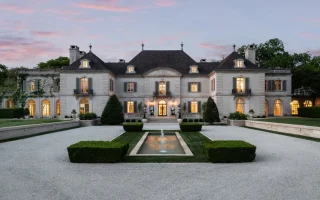Joyce Meyer, a world-renowned Christian author and speaker, embodies a message of hope, faith, and overcoming life’s challenges. Her teachings have touched millions, and her success is reflected in her stunning Eureka, Missouri mansion. This sprawling estate isn’t simply a luxurious home; it’s a physical manifestation of Joyce Meyer’s journey and a testament to how faith can shape the spaces we inhabit.
Architectural Style: A Blend of Classic and Contemporary
Joyce Meyer’s mansion strikes a balance between traditional grandeur and modern elegance. Its imposing facade features classic architectural elements like columns, arched windows, and a symmetrical design. These elements evoke a sense of stability, permanence, and perhaps subtly reference the timeless nature of the spiritual principles Joyce Meyer promotes.
However, the interiors showcase a lighter, more contemporary touch. Clean lines, open spaces, and an abundance of natural light create a sense of serenity and openness that welcomes reflection and rejuvenation. This blend of classic and contemporary might mirror how Meyer’s teachings often pair timeless Biblical wisdom with practical applications for the modern world.
Materials and Textures: Opulence with a Purpose
The materials used throughout Joyce Meyer’s home exude luxury and refinement. Rich hardwoods, gleaming marble, and plush fabrics speak to the success she has found through her ministry. However, these opulent materials are never simply for show. They serve a greater purpose in creating an atmosphere conducive to both spiritual contemplation and joyful living.
For example, the soft carpets and plush furnishings in Meyer’s home foster a sense of comfort and ease. This aligns with her approach to faith, which emphasizes God’s love and the availability of peace in everyday life.
Layout: Spaces for Reflection and Connection
The floorplan of Joyce Meyer’s mansion emphasizes a balance between spaces for personal reflection and those designed for gathering and connection. A dedicated prayer room or meditation space likely plays a central role, mirroring how Meyer stresses the importance of developing a personal relationship with God.
At the same time, the large living areas, expansive dining room, and inviting kitchen demonstrate a focus on hospitality and fellowship. This reflects Joyce Meyer’s strong belief in the power of community and the importance of sharing life’s journey with others.
Unique Features: Personalizing Faith
Beyond its overall design, Joyce Meyer’s mansion likely houses unique features that speak to her individual faith journey. These might include:
Artwork Reflecting Faith
Carefully chosen paintings or sculptures that reference biblical stories or Christian symbolism. Meyer might favor works that depict themes of overcoming adversity, finding joy in trials, or the transformative power of faith. For example, a painting of David facing Goliath could symbolize overcoming challenges through faith, while a sculpture depicting the nativity scene could represent hope and new beginnings.
Library: A Sanctuary for Study
A well-stocked library filled with Bibles, commentaries, and other theological resources. This space likely reflects Meyer’s dedication to studying scripture and deepening her understanding of her faith. The library shelves might be lined with Bibles in various translations, theological commentaries from respected scholars, and inspirational biographies of other faith leaders.
Water Features: Symbols of Peace and Renewal
Fountains or reflective pools can symbolize peace, cleansing, or spiritual renewal. Their gentle sounds could bring an element of tranquility to Meyer’s home. Imagine a cascading fountain in a serene courtyard, or a still reflecting pool surrounded by greenery, creating a space for quiet contemplation.
Inspirational Inscriptions Throughout
Verses or inspirational quotes inscribed throughout the home serve as constant reminders of one’s beliefs. Meyer might choose passages from the Bible that have encouraged her or resonate with her teachings. Uplifting quotes from Christian authors or historical figures could also be present. These inscriptions might be elegantly etched on walls, displayed on decorative plaques, or woven into tapestries.
Personal Touches Intertwining Faith and Family
Look for items with sentimental value, such as family heirlooms displayed alongside religious symbols. These intertwine Meyer’s individual story with her faith. A cherished family portrait could hang beside a crucifix, or a collection of seashells gathered on a mission trip might be displayed near a statue of the Virgin Mary.
Takeaways for Your Own Home
While few of us can replicate the scale of Joyce Meyer’s mansion, we can absolutely draw inspiration from its faith-centered design. Here’s how to incorporate those elements into your own space:
Create Comfort and Ease
Prioritize soft textures and inviting furnishings to make your home a sanctuary. Choose fabrics that feel soothing, incorporate plush pillows, and consider warm throws for added coziness. Think about the feeling you want to evoke – a relaxing retreat, a warm embrace, or a haven from the outside world. Select furniture that is comfortable and inviting, with ample seating for relaxation and conversation.
Designate a Reflective Space
Create a designated area for meditation, prayer, or simply quiet contemplation, even if it’s a cozy corner with a comfortable chair. A small table to hold a Bible, journal, or candle can enhance the atmosphere. This space should be free from distractions and clutter, allowing you to focus on your inner peace and spiritual connection.
Incorporate Symbols of Faith
Tastefully incorporate religious artwork, sculptures, or items that reflect your beliefs. A framed verse, a cross, or a piece of nature that holds spiritual meaning can be a powerful focal point. These symbols can serve as a source of inspiration and comfort, reminding you of your faith throughout the day.
Focus on Natural Light
Abundant natural light or soft, warm lighting creates a welcoming and peaceful atmosphere. Consider sheer curtains to let in sunlight, and use lamps with warm-toned bulbs for a comforting glow. Natural light has been shown to improve mood and reduce stress, while warm lighting creates a sense of relaxation and security.
Foster Gathering Places
Ensure your home has spaces designed to foster connection and community. Whether it’s a spacious dining table or a comfortable seating arrangement in the living room, create areas that encourage spending quality time with loved ones. This could be a cozy nook for intimate conversations, a game room for family fun, or a large dining area for hosting gatherings.
Joyce Meyer’s Eureka mansion stands as a testament to the power of faith to shape our physical environments. By understanding its design choices, we can glean valuable lessons on how to create homes that nourish our spirits and reflect our deepest values.
Conclusion
Joyce Meyer’s Eureka mansion is a magnificent example of how our living spaces can mirror our inner beliefs. Whether you’re drawn to the grandeur of her home, her message of hope, or simply the idea of mindful interior design, there’s much to learn. By incorporating elements of comfort, reflection, symbolism, and a focus on connection, we can all transform our homes into havens that reflect our values and nurture our spirits.




